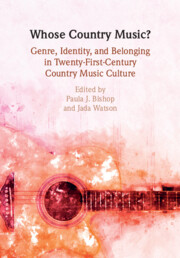Book contents
- Whose Country Music?
- Whose Country Music?
- Copyright page
- Contents
- Figures
- Tables
- Contributors
- “She went to Nashville to sing country music”
- Part I Industry
- Part II Codes of Conduct
- 5 Why Country Music Needs Latina Feminism
- 6 Pistol Annies
- 7 From Bros to Gentlemen
- 8 Cowboys on a Beach
- Part III Authenticity
- Part IV Boundary Work
- Bibliography
- Index
6 - Pistol Annies
Country Rebels with Humor
from Part II - Codes of Conduct
Published online by Cambridge University Press: 03 February 2023
- Whose Country Music?
- Whose Country Music?
- Copyright page
- Contents
- Figures
- Tables
- Contributors
- “She went to Nashville to sing country music”
- Part I Industry
- Part II Codes of Conduct
- 5 Why Country Music Needs Latina Feminism
- 6 Pistol Annies
- 7 From Bros to Gentlemen
- 8 Cowboys on a Beach
- Part III Authenticity
- Part IV Boundary Work
- Bibliography
- Index
Summary
Humor has been a prevalent performative strategy in country music since the commercial genre was first produced and marketed via radio and recording in the 1920s. Yet few scholars have examined the use of comedy in women’s performances, apart from Minnie Pearl’s stage act. This chapter demonstrates how women in twenty-first-century country music, specifically the Pistol Annies, a trio comprised of Miranda Lambert, Angaleena Presley, and Ashley Monroe, have used the comedic practices established by mid-century female country artists as a rhetorical means to challenge patriarchal power structures and white middle-class pretenses. Like their predecessors, the Pistol Annies have turned the incongruity of the “unruly woman,” defined by feminist media scholar Kathleen Rowe as a “rule-breaker, joke-maker, and public, bodily spectacle,” into campy and parodic performances of white, rustic working-class women transgressing the control and rigidity of dominant society and the white patriarchal frame of country music.
Keywords
- Type
- Chapter
- Information
- Whose Country Music?Genre, Identity, and Belonging in Twenty-First-Century Country Music Culture, pp. 87 - 101Publisher: Cambridge University PressPrint publication year: 2022

